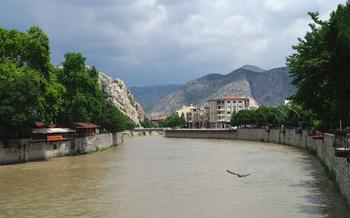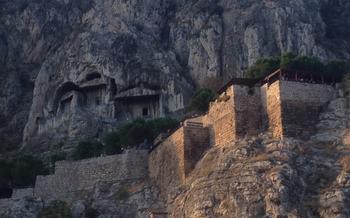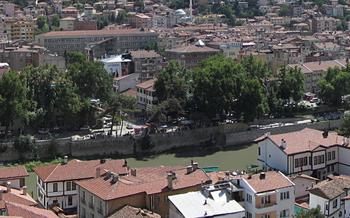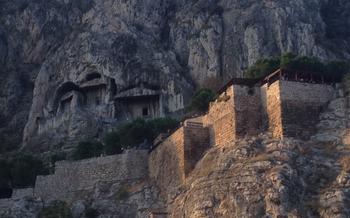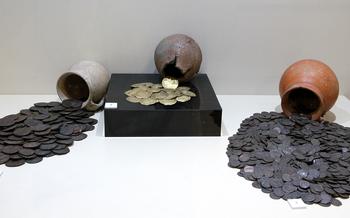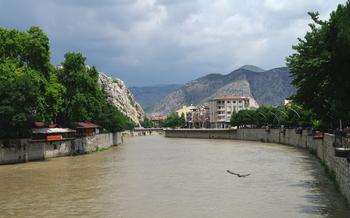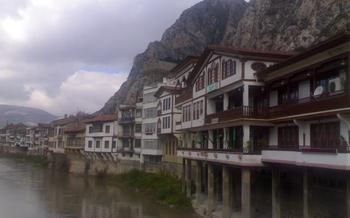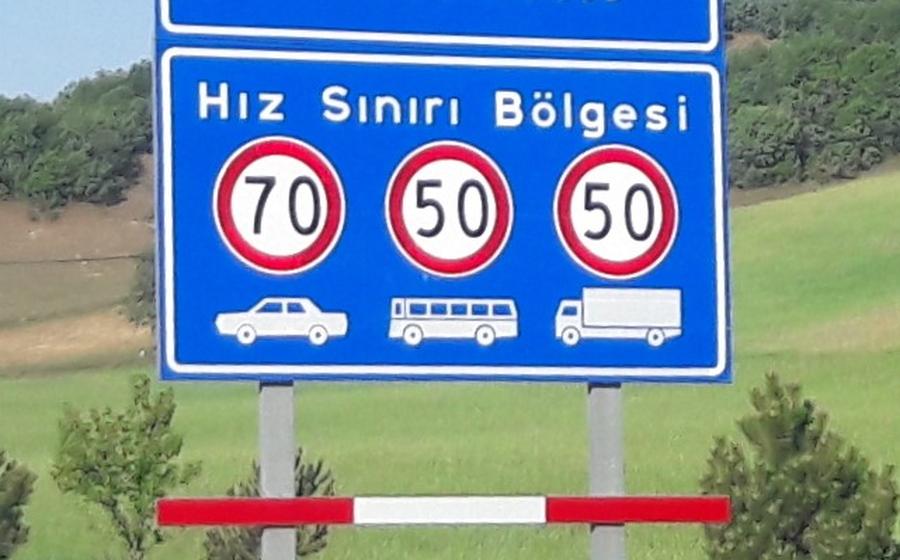
Kaya Tombs of Amasya rock cut tombs of ancient kings (in the nearby region of Amasya)
- A Journey into History: Exploring the Kaya Tombs of Amasya
- Exploring the Tombs: A Step-by-Step Guide
- How to get to the tombs from Çorum
- Tips for planning your visit
- What to expect during your visit
- Navigating the site and finding the most impressive tombs
- The History Behind the Tombs
- Architectural Marvels: The Design of the Tombs
- Symbolic Meanings and Iconography
- Women's Tombs: A Glimpse into Gender Roles
- Preservation and Conservation Efforts
- Unveiling the Secrets of the Tombs: Archaeological Discoveries
- The Surrounding Area: A Blend of Nature and History
- Visitor Tips for a Memorable Experience
- Accessibility and Facilities
- Recommended Tours and Itineraries
A Journey into History: Exploring the Kaya Tombs of Amasya
Brief history of the tombs
Carved into the towering cliffs overlooking the picturesque city of Amasya, the Kaya Tombs stand as a testament to the rich cultural heritage of Turkey. These ancient rock-cut tombs, dating back to the 4th century BC, served as the final resting places for the kings and nobles of the ancient kingdom of Pontus. The tombs, with their intricate carvings and symbolic motifs, offer a glimpse into the lives, beliefs, and artistic traditions of this once-powerful kingdom.
Their significance in the region's cultural heritage
The Kaya Tombs hold immense significance in the cultural heritage of the Amasya region. They represent a remarkable fusion of Hellenistic and Persian architectural styles, reflecting the diverse influences that shaped the history of this ancient land. The tombs have survived the passage of time, serving as a reminder of the region's rich past and its role as a crossroads of civilizations.
Location and accessibility
Situated just a short distance from the city center of Amasya, the Kaya Tombs are easily accessible by car or public transportation. Visitors can follow the signs leading to the tombs from the city center, and on-site parking is available for those driving. The tombs are located within a well-maintained park, providing a serene setting for exploration and contemplation.
General layout and design of the tombs
The Kaya Tombs are characterized by their unique rock-cut architecture, with each tomb carved directly into the cliff face. The tombs vary in size and shape, ranging from simple, single-chambered structures to more elaborate and ornate chambers. The entrances to the tombs are often adorned with intricate carvings and moldings, hinting at the grandeur that awaits within.
Exploring the Tombs: A Step-by-Step Guide
How to get to the tombs from Çorum
The Amasya Kaya Tombs are located approximately 80 kilometers from Çorum city. To get there, you can take a bus or rent a car. The journey by bus takes about two hours, while driving takes around one hour and 30 minutes. Once you arrive in Amasya, follow the signs to the tombs, which are situated on a hill overlooking the city.
Tips for planning your visit
Before your visit, check the weather forecast and dress accordingly. The tombs are exposed to the elements, so it's essential to be prepared for sun, rain, or cold weather. Wear comfortable shoes as you'll be doing a lot of walking on uneven terrain. Bring water and snacks as there are no food or beverage options at the site.
What to expect during your visit
As you approach the tombs, you'll be struck by their sheer size and grandeur. The tombs are carved into the sheer rock face and vary in size from small, single-chambered tombs to large, multi-chambered structures. Some tombs are adorned with intricate carvings and decorations, while others are more austere.
Navigating the site and finding the most impressive tombs
The tombs are scattered across a wide area, so it's helpful to have a map or guide to help you find the most impressive ones. Some of the must-see tombs include the Tomb of Mithridates VI, the largest and most elaborate tomb in the complex, and the Tomb of the Amazons, which is believed to be the burial place of a group of female warriors.
The History Behind the Tombs
The Amasya Kaya Tombs are a testament to the rich history and cultural heritage of the ancient kingdom of Pontus. The kingdom, which existed from the 3rd century BC to the 1st century AD, was ruled by a dynasty of kings known as the Mithridatids. The tombs served as the final resting places for these rulers and their families, as well as for other prominent figures in Pontic society.
The tombs are significant in the context of Pontic culture as they provide valuable insights into the beliefs, customs, and artistic traditions of this ancient civilization. The elaborate carvings and decorations found on the tombs depict scenes from mythology, hunting, and everyday life, offering a glimpse into the values and worldview of the Pontic people.
In terms of funerary practices, the tombs reflect the importance that the Pontic people placed on honoring their dead. The tombs were carefully constructed and decorated, and the bodies of the deceased were often accompanied by grave goods such as jewelry, pottery, and weapons. These objects were believed to accompany the deceased into the afterlife, providing them with comfort and protection.
Over time, the tombs have been subjected to natural erosion and damage, as well as looting and vandalism. However, thanks to the efforts of archaeologists and conservationists, many of the tombs have been preserved and restored, allowing visitors to appreciate their beauty and historical significance.
Architectural Marvels: The Design of the Tombs
The Amasya Kaya Tombs stand as remarkable examples of ancient rock-cut architecture, showcasing a diverse range of shapes, sizes, and intricate carvings. These tombs were meticulously carved into the sheer rock cliffs, and their unique designs reflect the artistry and craftsmanship of the ancient Pontus civilization.
The variety of tomb shapes is striking, ranging from simple rectangular chambers to elaborate multi-chambered structures. Some tombs feature imposing facades with intricate carvings, while others are adorned with decorative elements such as pediments, columns, and cornices. These decorative features draw inspiration from both Hellenistic and Persian styles, blending influences from different cultures to create a unique architectural style.
The tombs' interiors are equally impressive, showcasing a range of decorative motifs and carvings. These carvings depict a variety of subjects, including animals, geometric patterns, and human figures, each holding symbolic meanings related to Pontic beliefs about life, death, and the afterlife.
The tombs' unique design and decorative elements provide valuable insights into the cultural and artistic traditions of the ancient Pontus kingdom. They serve as a testament to the skill and creativity of the artisans who created these impressive monuments, leaving a lasting legacy that continues to captivate visitors to this day.
Symbolic Meanings and Iconography
The Amasya Kaya Tombs are adorned with a rich array of symbols and motifs that hold profound cultural and religious significance. These symbols provide valuable insights into the beliefs and practices of the ancient Pontic people.
Animal figures are a common motif, often depicting lions, bulls, and eagles. Lions symbolize strength and power, while bulls represent fertility and virility. Eagles, with their ability to soar high above the earth, embody the concept of transcendence and the journey of the soul to the afterlife.
Geometric patterns, such as circles, triangles, and spirals, are also prevalent in the tombs. Circles represent eternity and the cyclical nature of life and death. Triangles symbolize the divine, while spirals evoke the concept of infinity and the interconnectedness of all things.
Human representations are another important element of the iconography found in the tombs. These figures, often depicted in various poses and gestures, may represent the deceased individuals buried within the tombs, their ancestors, or deities worshipped by the Pontic people.
The combination of these symbols and motifs creates a rich visual narrative that speaks to the spiritual beliefs and cultural values of the ancient Pontic civilization. By deciphering these symbols, we gain a deeper understanding of their worldview, their concept of the afterlife, and their relationship with the divine.
Women's Tombs: A Glimpse into Gender Roles
Among the Amasya Kaya Tombs, several are dedicated to women, providing a valuable glimpse into the role of women in Pontic society. These tombs stand as a testament to the importance and influence women held within the kingdom.
The presence of women's tombs challenges traditional views of gender roles in ancient Anatolia, where women were often seen as subordinate to men. These tombs suggest that women in Pontus enjoyed a higher status and played significant roles in society.
The unique features and decorations found in the women's tombs further highlight their importance. These tombs are often smaller in size compared to those of men, but they are adorned with intricate carvings, delicate motifs, and vibrant colors.
The symbolism and iconography found in the women's tombs also provide insights into their beliefs and values. Representations of female deities, fertility symbols, and scenes of domestic life suggest that women were revered for their roles as mothers, nurturers, and guardians of the hearth.
Exploring the women's tombs at the Amasya Kaya Tombs offers a unique opportunity to challenge traditional gender narratives and gain a deeper understanding of the diverse roles women played in ancient Pontic society. These tombs serve as a reminder of the strength, influence, and contributions of women throughout history.
Preservation and Conservation Efforts
The Amasya Kaya Tombs have endured the passage of time, weathering the elements and human interventions. However, preserving these ancient treasures poses unique challenges. The tombs' exposed location makes them vulnerable to erosion caused by wind, rain, and fluctuating temperatures. Moreover, the porous nature of the rock allows moisture to seep in, causing deterioration from within.
To address these challenges, ongoing conservation efforts aim to protect the tombs from further damage. Experts employ a range of techniques, including regular cleaning and maintenance, to prevent the accumulation of dirt and debris. Structural reinforcements and stabilization measures help to ensure the tombs' stability, preventing collapse or damage from earthquakes.
Sustainable tourism practices play a crucial role in preserving the site. Controlled access and designated pathways minimize the impact on the tombs and their surroundings. Educational initiatives raise awareness among visitors about the importance of responsible tourism and encourage them to respect the site's fragile heritage.
Visitors can contribute to the preservation efforts by adhering to designated trails, avoiding touching or climbing on the tombs, and refraining from using flash photography. By respecting these guidelines, visitors help ensure that these ancient wonders remain intact for future generations to appreciate and enjoy.
Unveiling the Secrets of the Tombs: Archaeological Discoveries
The Amasya Kaya Tombs have been a treasure trove for archaeologists, yielding significant discoveries that have shed light on the history and significance of the site. Over the years, systematic excavations and surveys have uncovered a wealth of artifacts, including pottery, coins, jewelry, and inscriptions. These findings have provided valuable insights into the daily lives, cultural practices, and artistic traditions of the ancient Pontic kingdom.
One of the most remarkable discoveries was the tomb of a high-ranking official named Mithridates, which contained a rich collection of gold and silver artifacts. The tomb's elaborate decorations, including intricate carvings and a stunning mosaic depicting a hunting scene, offered a glimpse into the opulence and luxury enjoyed by the Pontic elite.
Another significant find was a collection of royal seals, each bearing the image of a different Pontic king. These seals played a crucial role in authenticating documents and asserting royal authority. Their discovery has helped historians to establish a clearer chronology of the Pontic dynasty and to better understand the administrative structures of the kingdom.
In recent years, the use of advanced technology, such as ground-penetrating radar and laser scanning, has revolutionized archaeological research at the Amasya Kaya Tombs. These techniques have allowed archaeologists to map the underground chambers and structures, revealing hidden tombs and providing new insights into the site's layout and design.
The ongoing quest to learn more about the tombs and the people who built them continues to drive archaeological research at the site. Each new discovery brings us closer to understanding the rich history and cultural significance of the Amasya Kaya Tombs, solidifying their place as one of Turkey's most important archaeological treasures.
The Surrounding Area: A Blend of Nature and History
The region surrounding the Amasya Kaya Tombs is a treasure trove of natural beauty and historical landmarks, offering visitors a chance to immerse themselves in the rich cultural heritage of the area.
Natural Wonders:
The Yeşilırmak River, with its crystal-clear waters and lush greenery, meanders through the region, creating a picturesque landscape ideal for relaxation and exploration. Visitors can embark on a scenic boat tour to admire the river's beauty from a unique perspective, spot diverse bird species, and unwind amidst the tranquil surroundings.
Amasya Castle:
A short distance from the tombs, the majestic Amasya Castle stands as a testament to the region's rich history. Perched atop a hill overlooking the city, the castle offers breathtaking panoramic views and a glimpse into the lives of past civilizations. Explore its ancient fortifications, wander through its atmospheric courtyards, and immerse yourself in the legends and stories that echo within its walls.
Outdoor Adventures:
The area surrounding the Amasya Kaya Tombs is a paradise for outdoor enthusiasts. Hiking trails wind through scenic landscapes, leading to hidden waterfalls, secluded valleys, and breathtaking viewpoints. Birdwatching enthusiasts can delight in the diverse avian population, including migratory species that grace the region during different seasons.
Combining History and Nature:
A visit to the Amasya Kaya Tombs can be seamlessly combined with a broader exploration of the region's natural and historical attractions. Plan an itinerary that allows you to delve into the ancient mysteries of the tombs while also experiencing the beauty of the surrounding landscapes, creating a truly immersive and unforgettable travel experience.
Visitor Tips for a Memorable Experience
To make the most of your visit to the Amasya Kaya Tombs, here are some insider tips:
- Plan your visit during the shoulder seasons (spring or fall) to avoid the summer crowds and enjoy more pleasant weather.
- Wear comfortable shoes as you'll be doing a lot of walking on uneven terrain.
- Bring a hat, sunglasses, and sunscreen to protect yourself from the sun.
- Pack a camera to capture the stunning views and intricate details of the tombs.
- Be respectful of the site and its cultural significance. Avoid touching or climbing on the tombs, and refrain from littering.
- If you have any questions or need assistance, don't hesitate to ask the on-site staff or a tour guide.
Accessibility and Facilities
The Amasya Kaya Tombs are committed to ensuring accessibility for visitors with disabilities. Wheelchair ramps and designated parking spaces are available at the site, making it easy for visitors with limited mobility to explore the tombs.
Restrooms are located near the entrance of the site, providing convenience for visitors. However, it's important to note that the tombs themselves may require some climbing and uneven terrain, so visitors with mobility concerns may need assistance or choose to focus on the more accessible areas.
For those who prefer a guided experience, the site offers guided tours in various languages. These tours provide a wealth of information and insights into the history, significance, and symbolism of the tombs. Visitors can book guided tours in advance or inquire about availability upon arrival.
Food and beverage options are limited at the site, so it's advisable to bring snacks and water, especially if you plan to spend a significant amount of time exploring the tombs. However, there are several restaurants and cafes in the nearby town of Amasya, where visitors can enjoy a delicious meal or a refreshing beverage after their visit.
Family-friendly facilities are available at the site, including designated areas for children to play and rest. The tombs themselves are relatively safe for children to explore, but adult supervision is recommended, especially for younger children.
The Amasya Kaya Tombs strive to provide a welcoming and enjoyable experience for all visitors. By offering accessibility features, guided tours, and family-friendly facilities, the site ensures that everyone can appreciate the wonders of these ancient rock-cut tombs.
Recommended Tours and Itineraries
Navigating the Amasya Kaya Tombs and the surrounding region can be overwhelming due to the abundance of historical sites and natural beauty. To make the most of your visit, consider joining a guided tour or crafting a personalized itinerary. Guided tours offer a wealth of knowledge and insights into the history, culture, and significance of the tombs. They typically cover the main highlights, including the most impressive tombs and the surrounding landscapes.
When planning your own itinerary, start by prioritizing the tombs you want to explore. Allocate ample time to wander through the site, admiring the intricate carvings and soaking in the atmosphere. Consider exploring the surrounding area, which boasts a diverse range of attractions. The Yeşilırmak River offers opportunities for scenic boat rides or peaceful riverside walks. Amasya Castle, perched atop a hill, provides panoramic views of the city and the surrounding countryside.
If time permits, venture beyond the immediate vicinity of the tombs. The region is dotted with charming villages, ancient ruins, and natural wonders. Consult local tourism offices or online resources for recommendations and detailed itineraries. Whether you prefer organized tours or independent exploration, the Amasya Kaya Tombs and the surrounding area offer a rich and rewarding experience for history enthusiasts and nature lovers alike.

